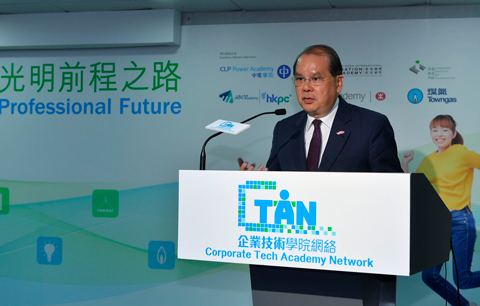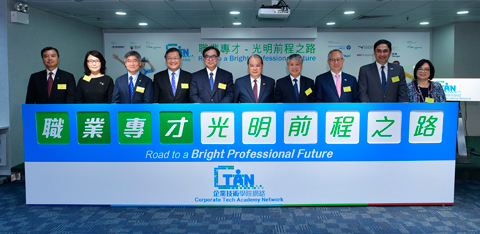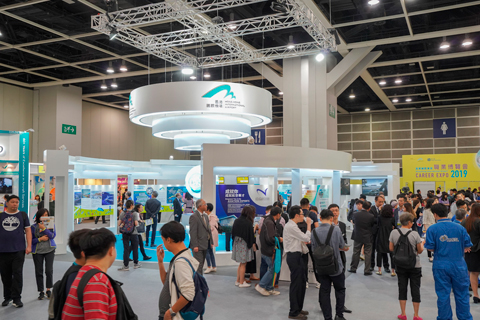Alliance of Six Corporations to boost education and training Joint efforts to nurture young people and promote upward mobility
9 June 2019
In recent years, more and more Hong Kong enterprises have set aside their differences and worked together to uphold their corporate social responsibilities in the interest of the overall development of Hong Kong through co-operating with education and training providers to develop courses for specific industries or professions and promoting vocational and professional education and training (VPET) actively to nurture talent for Hong Kong. The efforts are all aimed at meeting our manpower requirements for the continuous advancement of society.
This is a major but low-profile “silent revolution” as well as a change in corporate culture. As an official who has worked for more than two decades on labour and manpower policies and in the areas of education and training, youth development, promoting upward mobility in society and helping the poor and the disadvantaged, I am deeply impressed by such a development.

|

|
Last month (on 21 May), I attended an activity entitled “Road to a Bright Professional Future”, which was organised by the Corporate Tech Academy Network (CTAN) to provide young people with information on VPET and STEM education. CTAN is an alliance formed by six corporate academies, namely the CLP Power Academy, the Hong Kong Institute of Construction, the MTR Academy, the HKPC Academy, the Hong Kong International Aviation Academy and the Towngas Engineering Academy.
By pooling together the efforts of various sectors and industries, CTAN creates synergy by making use of its network platform while, at the same time, it recongises the importance of VPET for social development. Last year (2018), as many as over 5 000 people graduated from the academies of CTAN (excluding short-term courses).
I would like to thank the member corporations of CTAN for forming such a big alliance. It is a strategic and forward-looking move to establish a vocational talent pool for Hong Kong, so that our “chariot of talent” may dash ahead. The Government will continue to actively work with various sectors of the community to promote VPET. I hope that more and more corporations will join CTAN to fulfil their social responsibilities, as a result of which our “chariot of talent” can be strengthened.
CTAN offers diversified programmes that meet the needs of Hong Kong’s economic and social development. For example, the Diploma in Aviation Operations offered by the Hong Kong International Aviation Academy provides young people aspiring to join the aviation industry with courses that focus on both theory and practical training and incorporate job matching, so that the trainees can learn and earn from their work on the way to obtaining recognised academic qualifications and professional expertise and realise their aviation dreams.
The demand for talent in the aviation industry is ever increasing. Hong Kong is an international aviation hub and our airport has consistently been ranked among the world’s top three. The airport’s three-runway system project is scheduled for completion by the end of 2024. Following the commencement of the three-runway system, around 120 000 direct jobs and nearly 160 000 indirect or induced jobs (including aviation-related and unrelated jobs) will be provided. This is a remarkable growth of manpower requirement over the current number of staff working at the airport, i.e. 73 000.

|
Last week (on 31 May), the Airport Authority Hong Kong and the Labour Department jointly launched the Hong Kong International Airport Career Expo 2019, which offered over 4 000 job openings at more than 40 companies across the airport community. The Expo was the eighth one in the series.
Apart from operating railway systems in Hong Kong, the Mainland and Macao, the MTR Corporation also participates actively in the operation and management of international railway systems, including Melbourne’s metropolitan rail service in Australia and the Stockholm Metro in Sweden. It has also been awarded the concession to operate the Crossrail (Elizabeth Line) train service and the South Western Railway in the United Kingdom.
With a view to nurturing railway-and-transport-related professionals, the MTR Academy offers three programmes, namely the Advanced Diploma in Railway Engineering, the Advanced Diploma in Transport Operations and Management and the Diploma in Transport Studies, to provide structured and accredited courses for local trainees. Since its establishment in 2016, the MTR Academy has trained more than 2 300 staff.
Meanwhile, the construction industry in Hong Kong continues to thrive. The Government’s total capital investment in infrastructure in the next decade is estimated at over $1 trillion. Given the keen demand for labour in the construction industry in Hong Kong, we have been endeavouring to enhance manpower training for the industry.
The four corporate academies which are closely related to the construction and engineering fields, namely the CLP Power Academy, the Hong Kong Institute of Construction, the HKPC Academy and the Towngas Engineering Academy, have continued to organise diversified programmes at different levels that serve the needs of the future development of Hong Kong.
The Government has all along endeavoured to provide flexible and diversified pathways with multiple entry and exit points for secondary school graduates, so as to help them unleash their full potential and achieve their best. I would like to point out that university education is not the only progression pathway for further studies, and definitely not the only definition for success. The Government offers multiple progression pathways to young people with diverse aspirations and abilities through VPET, which includes programmes at different levels, such as bachelor degree programmes, sub-degree programmes and diploma programmes.
It is worth noting that most students and parents see degree programmes as their preferred choice and usually overlook the important role played by VPET in providing career opportunities with a promising future. This is because, to a large extent, people barely know about VPET or have a wrong perception of VPET. I am confident that if people know more about VPET programmes and their relation to the Qualifications Framework, they will see that VPET can lead to a bright career future.
In fact, there are many success stories about VPET. Take this example. When a student has completed the required basic training course and obtained the qualification of a mechanic, he can proceed to higher diploma or professional diploma programmes if he meets the entry requirements. Afterwards, he may progress to take professional or vocational degree programmes (e.g. Bachelor of Engineering Programme) to obtain professional qualifications (e.g. engineer).
VPET places equal emphasis on theory and practice. By learning to do and doing to learn, VPET students can accumulate relevant work experiences. Sooner or later, they may outstrip university graduates in terms of pay and career prospects.
Here, I would like to share my ideas with students and parents. Whatever the results of public exams, there are a wide range of pathways and a promising future awaiting our younger generation. Sometimes, it may not be easy to choose from a large number of options available. My advice to students is that they should make good use of the time ahead of the release of the results to review their study or career plans and get prepared early, so that they can choose your pathways according to your interests and abilities.

